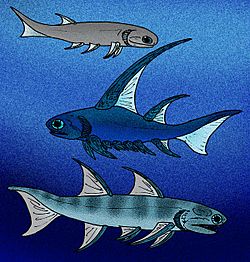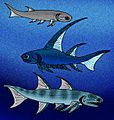Acanthodii facts for kids
Quick facts for kids AcanthodiiTemporal range: Early Silurian - Permian
|
|
|---|---|
 |
|
| Different extinct fishes of Early Devonian | |
| Scientific classification | |
| Kingdom: | |
| Phylum: | |
| Subphylum: | |
| Infraphylum: | |
| (unranked): | |
| Class: |
Acanthodii
|
| Orders | |
|
Climatiiformes |
|
Acanthodii (sometimes called spiny sharks) is a class of extinct fishes, having features of both bony fish (Osteichthyes) and cartilaginous fish (Chondrichthyes). They appeared in the early Silurian (430 mya) and lasted until the late Permian (250 mya). The earliest ancanthodians were marine, but during the Devonian, freshwater species became predominant. They are distinguished in two respects: they were the first known jawed vertebrates, and they had stout spines supporting their fins, fixed in place and non-movable (like a shark's dorsal fin).
Images for kids
-
Three acanthodians from the Early Devonian of Great Britain: Mesacanthus (an acanthodiform), Parexus (a "climatiiform"), and Ischnacanthus (an ischnacanthiform)
-
Impression fossil of the diplacanthid Rhadinacanthus longispinus, at the Museum für Naturkunde, Berlin
-
Nerepisacanthus, a Silurian acanthodian known from decent fossils
-
Various acanthodians, from top left clockwise: Cheiracanthus, Acanthodes, Climatius, Ischnacanthus, Parexus, Gyracanthus. center: Diplacanthus.
See also
 In Spanish: Acantodios para niños
In Spanish: Acantodios para niños





